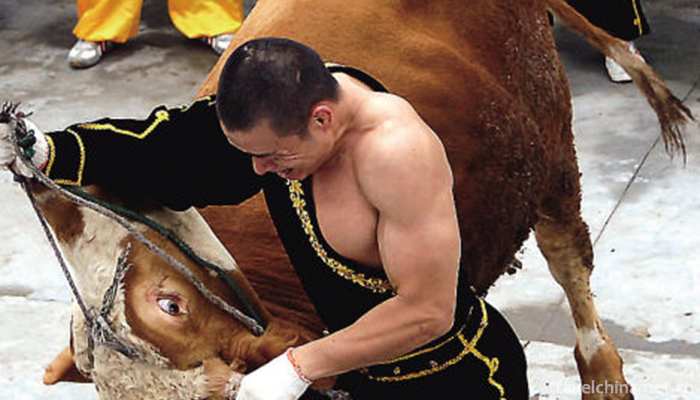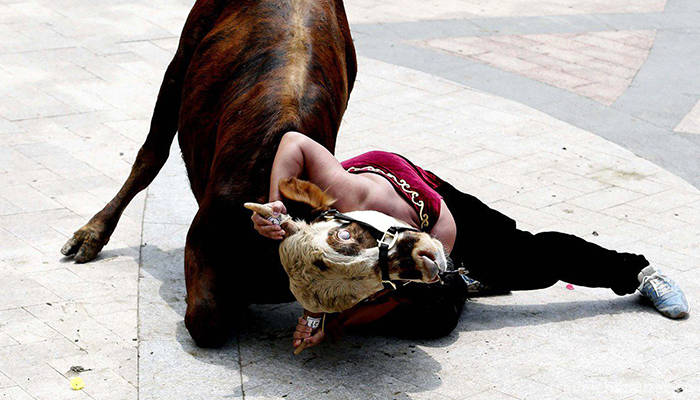Bullfight
Bull-wrestling is a traditional competitive sport of the Hui people. It means throwing, wrestling and throwing. It can also be called bullfighting of the Hui people. The Hui's bullfight is different from the Spanish bullfight. The Spanish bullfight needs to stab the bull with a sword. But the Hui people's cows, without any weapons, completely rely on personal courage and physical strength to throw the cattle down.
origin
The activity of cattle-feeding has been paid more attention in Hui inhabited areas, which is closely related to the Hui people's preference for beef and the frequent slaughter of cattle. Legend has it that a long time ago, there was a returning camp, living in nearly a thousand families, they have to slaughter hundreds of cattle every year during the Eid al-Adha. Every time the cattle were slaughtered, four or five strong young men took ropes and sticks and tied them together and fell. On one occasion, when a bull was tied up, a young man was injured by the bull. Soon he became "impermanent", and the villagers were very sad about it. On the second year of Eid al-Adha, there was a brave and intelligent young man, who was quick-sighted and did not need help. One man threw the cattle down with quick action. The villagers are full of praise and legends. Under his influence, every year to the Eid al-Adha, there are many shrewd young men to grab cattle one by one. Since then, cowling has become a traditional sports activity favored by the Hui people. Every year, the Eid al-Adha Festival specializes in performing.
rule
There are no strict rules for cow-rolling, mainly for the purpose of cattle-rolling in a certain period of time according to the strength and skills of each person. When the Hui people perform with cows, they are usually smart and flexible. When facing the big bull with sword-like antennae and thunderous jump, they step forward, grasp two horns with both hands, concentrate on them, and twist the head of the bull to one side. Then they immediately take the chin of the bull with their right shoulder and force the neck of the bull to another. The front feet of the bull kneel down immediately, and then press the neck of the bull forcefully through a series of twisting, carrying and pressing. The action brought down the bull and made it look up on all fours.
The rules are simple and the process is unique. The cowman's assistant first flirted with the cattle, causing them to run across the field. At this time, the Cowman appeared on the stage, facing the angry bull, the Cowman chose two hands to pull the horns of the bull, twist the head to one side, the cow struggled hard, the Cowman immediately held the head tightly, shouldered the chin of the cow, exerted all his strength, put his body on the neck of the cow, Newton lost balance, fell to the ground. This skill of twisting, carrying and pressing a cow is the main characteristic of a cow.
The state of cattle falling to the ground is divided into four grades according to the degree of technical difficulty.
Kneel on both knees (Level 4)
Abdominal landing (level 3)
Side to side (Level 2)
Four feet facing the sky (level 1)
The criteria for evaluating a cow depend on the skill of the Cowman and the different types of cattle falling to the ground. The types of cattle are single-arm, double-arm, shoulder, shoulder and so on.
On May 23, 2011, cows were listed in the third batch of national intangible cultural heritage list with the approval of the State Council.
Relevant
The Hui people's cows participated in the performance at the National Minority Sports Conference in 1982, and the audience applauded warmly. They were welcomed and praised by brothers and foreign Muslim friends.
cultural heritage
On May 18, 2010, the Ministry of Culture of China announced the third batch of national intangible cultural heritage list of recommended projects (new entries). Nanhu District, Jiaxing City, Zhejiang Province, declared the "cow" was included in the intangible cultural heritage of traditional sports, recreation and acrobatics.


0 Questions
Ask a Question
Your email address will not be published.